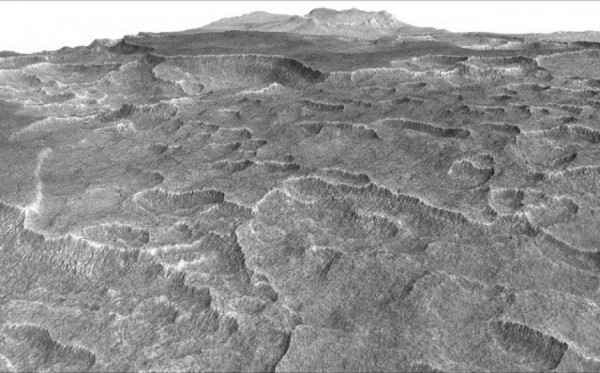By Ana Verayo, | November 23, 2016

This vertically exaggerated view shows scalloped depressions in a part of Mars. These textures prompted researchers to check for buried ice. (NASA/JPL-Caltech/University of Arizona)
A massive ice deposit has been discovered on Mars. The subsurface layer contains as much water as Lake Superior in Michigan, according to a new study.
Planetary scientists say that this ice layer is estimated to be as wide as the state of New Mexico. It is located in the mid-northern latitudes of Mars, just underneath 10 meters of soil. Scientists are excited about this newest discovery, as this ice deposit could be a crucial resource for a future Mars colony.
Like Us on Facebook
According to the co-author of the study, Jack Holt of the University of Texas, this could be the most accessible water source on Mars since it is located in a somewhat lower latitude region, resting on a flat surface. This suggests that a landing spacecraft can easily touchdown here than any area with buried ice.
The team from the Institute of Geophysics at the University of Texas used a radar instrument known as SHARAD (Shallow Radar) of NASA's Mars Reconnaissance Orbiter in the Utopia Planitia region of the Red Planet. This radar can detect subsurface objects and features. Scientists previously found "scalloped depressions" similar to Earth's Arctic region which led them to investigate this buried ice.
New data from SHARAD reveals ice deposits with layers as thick as 260 to 560 feet. The deposit is composed of 50 to 85 percent water ice, and the rest of it are dirt and rocks. Based on this, the water volume is estimated to be 2,900 cubic miles of liquid material.
Apart from this, SHARAD also possesses the ability to identify liquid water from frozen water. Utopia Planitia's buried ice is frozen at the moment.
Researchers say that this ice may have been liquid in Martian past when its poles were tilted at a different angle. Mars apparently has tilted to a 50-degree angle in a span of 120,000 years.
According to the co-author of the study, Joe Levy from the University of Texas, these ice deposits are not just a very important source for astronauts exploring Mars in the near future, it is also a valuable climate change record about the evolution of Mars.
The discovery of this massive buried ice deposit on Mars is detailed in the journal Geophysical Research Letters.
-
Use of Coronavirus Pandemic Drones Raises Privacy Concerns: Drones Spread Fear, Local Officials Say

-
Coronavirus Hampers The Delivery Of Lockheed Martin F-35 Stealth Fighters For 2020

-
Instagram Speeds Up Plans to Add Account Memorialization Feature Due to COVID-19 Deaths

-
NASA: Perseverance Plans to Bring 'Mars Rock' to Earth in 2031

-
600 Dead And 3,000 In The Hospital as Iranians Believed Drinking High-Concentrations of Alcohol Can Cure The Coronavirus

-
600 Dead And 3,000 In The Hospital as Iranians Believed Drinking High-Concentrations of Alcohol Can Cure The Coronavirus

-
COVID-19: Doctors, Nurses Use Virtual Reality to Learn New Skills in Treating Coronavirus Patients







